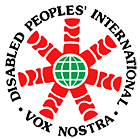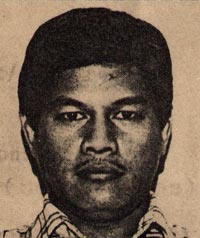History
Disabled People´s International (DPI) is a world cross-disability, self-help, human rights organizations of persons with disabilities established in 1981. We have been promoting full-participation and equalization of opportunity of persons with disabilities by delivering "A voice of our own." We hold special consultative status for the United Nations and have collaborated with many other international agencies as well. Disabled People´s International Asia-Pacific Region has been playing an important role in the disability movement of Asia-Pacific Region.
Regional Development Office was moved to Metropolitan Bangkok in 1999 to further promote disability movement in the Asia-Pacific Region.
Our Logo

From time immemorial, Homo Sapiens have responded dynamically to clarion calls and rallied round trappings of various forms of insignia. Symbols of one form or another have, throughout recorded history, evoked the human spirit to action. Examples of this are manifold.
In 1981, when the United Nations General Assembly Declared International Year of Disabled Persons - IYDP - was launched, the member states moved rapidly and relentlessly towards developing programmes and projects for the full and equal participation of persons with disabilities. Until then, and indeed during this period too, persons with disabilities all over the world had things done to them and for them. While lip-service was given to the full and equal participation of persons with disabilities, the reality was that persons with disabilities did not have a "Voice Of Our Own" - "Vox Nostra".
This imbalance had to be addressed. Fourteen motivated, committed and experienced grassroots persons with disabilities joined forces and forged a plan of action for that year. This plan was to culminate in the founding of the unique and historic movement of persons with disabilities as equals - Disabled Peoples´ International.
From the outset it was felt that there was a need to evolve slogans and symbols that would identify, signify and clarify the objectives and principles of the global movement. It needed a clarion call, it needed a totem pole. The clarion call was Vox Nostra (Voice Of Our Own) and the rallying totem was our logo, the wheel.
Our first step was to evolve a symbol which could demonstrate to the world and to persons with disabilities around the world the oneness and strength of persons with disabilities in their attributed separateness and weakness.
Unity in diversity and strength in our weakness
After much consideration and discussion and taking into account the varied cultural, socio-economic, religious and linguistic and ethnic groupings of our membership, and being mindful of the well-known Chinese adage "one picture is worth a thousand words", we in Singapore decided to embark upon developing a "totem pole" - a logo. The essential ingredients were:
- To create a global identity with and among persons with disabilities.
- The emphasis of equality of membership and the inclusion of all persons with disabilities, without exception or discrimination.
It was recognized that colours play an important role in expressing ideas, sentiments, philosophies, hence the GREEN, the WHITE and the RED of DPI.
The GREEN is to symbolise the countryside which is the home of more than 80% of the world's population with disabilities. It also signifies the environment and the need to protect , safeguard and cherish it. Green stands for freshness, springtime and growth and hoe for a better age for all.
WHITE has always been the colour for peace and neutrality, harmony and acceptance. It also can represent the purity and positivity of spirit, of knowledge and attitude towards all.
RED, the life-blood of our young movement, its vibrance, its vigour, its fertility, its joy and happiness in its will achieve equality, fraternity and freedom with justice.
For the first few years of DPI´s existence, DPI adopted a logo of its initials in solid capital letters. Within each letter were graphic representations of the different groups that constituted DPI. This was necessary as DPI had to reach out to millions of persons with disabilities and diversities. It had to put across its initials pictorially and to impress that DPI stood for all disability groups. The logo on the Back Cover illustrates this point.
The concept of the wheel in motion depicts a dynamic organization. The wheel itself is an all important invention. It has contributed greatly to the very progress of human kind.
The logo that Dpi created and adopted, originally used as the DPI's Congress logo and later adopted permanently, can symbolize the major categories of disabilities that exist in the world, through the 7-spokes focused upon the hub, which is the globe. (Please refer to Back Cover.) The seven categories are: orthopedic and motor, sensory, mental impairment, intellectually impaired, neurological, organ related and respiratory.
Some others may wish to interpret the spokes as represented in the seven regional divisions of the centralized globe, namely: Africa, Asia-Pacific, Middle East, Europe, North America, the Caribbean and Latin America.
Whatever the interpretation, the overall symbol is that people, whether they are with or without a disability, are jointly on the move. Static is to be dead. To be in motion or to be dynamic is to be alive and progressive.
We are a living, progressive, dynamic and vibrant movement standing for equal opportunities, justice and peace.
Written by Mr. Ron Chandran Dudley, Regional Advisor
First RDO
 On July 25, 1991, the DPI Asia Pacific Regional Development Officer, Danilo B. Delfin, reported to his duty station in Bangkok, Thailand, to establish the Asia Pacific Regional Office. Earlier, the host national assembly, Council of Disabled People of Thailand, had swung into action, mobilizing its membership to locate a residential unit to serve as both office and residence for the RDO and his family. They also made representations to their government for the provision of temporary non immigrant visas, pending government approval of the Regional Office.
On July 25, 1991, the DPI Asia Pacific Regional Development Officer, Danilo B. Delfin, reported to his duty station in Bangkok, Thailand, to establish the Asia Pacific Regional Office. Earlier, the host national assembly, Council of Disabled People of Thailand, had swung into action, mobilizing its membership to locate a residential unit to serve as both office and residence for the RDO and his family. They also made representations to their government for the provision of temporary non immigrant visas, pending government approval of the Regional Office.
The idea of a Regional Office in addition to the office of the Chairperson in Tokyo had been mooted at the Regional Council meeting in Dhaka, Bangladesh, as early as 1985. The idea was further reinforced by Mr. Riji Mizutani of the International Labour Organization to Regional Council members in Tokyo later in the same year. By the time of the Council meeting of 1986 in Seoul, Korea, a firm resolution was made mandating the Regional Chairperson, Senator Eita Yashiro of Japan, to find ways and means of establishing a regional office and securing funds. The Council meeting of 1987 in Islamabad, Pakistan, saw the region still trying to secure funding from the Development Program Office in Winnipeg, Canada. Finally with funds from the Canadian International Development Agency (CIDA), the office of the Chairperson began seriously studying options for the establishment of this office. It was reported in the Council meeting and Regional Assembly of 1988 in Bangkok, Thailand, that exploratory talks were being conducted with the United Nations Economic and Social Commission for Asia and the Pacific (ESCAP) for the establishment of a joint DPI - ESCAP unit in the Social Development Division of that office. By 1989, however, it was found that such an arrangement was more costly than maintaining an independent office. Thus, during the Council meeting of 1990 in Suva, Fiji, the decision was made to secure a rented house in Bangkok in the following fiscal year and a Regional Development Officer appointed by a selection committee set up during the same meeting.
The Regional Council drew up the following areas of duty of the Regional Development Officer:
- To help achieve the objectives and programs of the Regional Council
- To be responsible for the administration of the DPI Asia Pacific Regional Council
- To be responsible for the management of the DPI Asia Pacific Regional Council
- To work with National Assemblies and Sub-Regions in identifying and developing projects to benefit people with disabilities
- To locate the funders for the projects and activities in the region
The Regional Office is envisaged to be the focal point of the disability rights movement in the region. It can also serve as the regional information and coordination center. Towards this end cooperation with inter-governmental, governmental and non-governmental organizations as well as information sharing with organizations of professionals and uni-disability organizations is indispensable.
Noting the vital role that a regional office plays in the development or underdevelopment of the various regions of DPI, the Asia Pacific Regional Council faces the decade of the 90´s. Sobered by the enormity of the job ahead, yet challenged by the bright vision of liberating millions of disabled brothers and sisters taking their rightful and just place within their respective societies. The Regional Council affirmed that this would be their legacy to mankind, a testimony that peoples of different creeds, colors, religions and conditions can live and work peaceably together for the betterment and development of the whole human community.
Seven applicants from at least five countries applied for the position and by May 1991 Denilo B. Delfin was confirmed by the Regional Council as Regional Development Officer. Danny, as he is commonly called by friends, is a forty year old wheelchair user paralyzed from the waist down by a .38 bullet fired from a riot police revolver during his police college days in 1971.After spending one year, three months in the hospital and another year and a half at home, he started working as an administrative assistant in the alumni office of his Reservist Officers´ Training Corps (ROTC) association. Five years in this office made him yearn for more professional achievement and a higher income. Thus, in 1980 he resigned from this office and became a full time life insurance salesman. It was while he was working in this position that he first became involved with the Philippine National Commission Concerning Disabled Persons as Chairperson of the Sub-Panel on the Expansion of the Participation of Disabled Persons in All Aspects of Society, of the advisory panel of the 1981 International Year of Disabled Persons (IYDP). As sub-panel Chairperson he was therefore sent to attend the First World Congress of DPI in Singapore at the end of that "landmark´ year. He was elected to the Asia Pacific Regional Council and in 1983 during the first Regional Council meeting in Bangkok,Thailand, he was further elected as Vice Chairperson for the South East Asia Sub Region. In 1982 he had been appointed by the President of the Philippines to be the youngest Commissioner of the National Council of the Philippine National Steering Committee for the First National Congress of Disabled Persons, which saw the formation of the first national organization as Outstanding Disabled Person of the year. He became president of this national organization and as such he was again re-elected as Regional Council member and Vice Chairperson of the South East Asia Sub-Region during the first Asia Pacific Regional Assembly in Adelaide, Australia, in 1984 and then again in 1988 during the second AP Regional Assembly in Bangkok, Thailand. He took advantage of the of the postponement of the 3rd World Congress in Bogota, Colombia in 1989 to get married to Ana Elma Quiocho, a Public Health graduate and student of Physical Therapy with co-Regional Council member Russell Hunt of Australia as best man in absentia. In 1990 he stepped down as president of the Philippine National Organization of Disabled Persons and promptly applied for the Regional Development Officer´s position.
